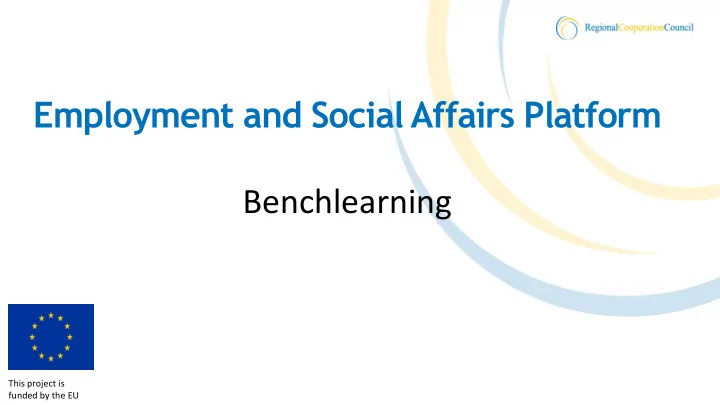

Employment and Social Affairs Platform Benchlearning This project is funded by the EU
Employment and Social Affairs Platform (ESAP) Overall objective : Strengthen regional cooperation and institutional capacities of national administrations, enabling them to develop and effectively implement labour market and social policy reforms in their EU enlargement process. Specific objective : Enhance capacities of relevant administrations for improved policy outcomes and policy reviews related to the prioritized employment, human capital and social policies.
Proposed agenda for the breakout group 10' Introduction to the Nand Shani Proposed benchlearning process breakout session 60' Presentation of national PES Presentation of quantitative perspectives representatives indicators 50' Discussion All participants Feedback on the proposed process 10' Summary of discussions Nand Shani Agree on topics and next steps and conclusions
Objective for peer reviews Improve organizational development and increase performance Link benchmarking with mutual learning
1. Quantitative benchmarking 1.1 Agreement on the set of quantitative data to be collected for the analysis Indicators proposed in the methodological note Transition rate from unemployment to employment Speed of transition PES market share in hirings Other relevant indicators proposed by the beneficiaries
1. Quantitative benchmarking (cont.) 1.2. Coordination of the collection of data with a time series starting in 2010, while benefiting from external technical and methodological advice and clarification 1.3. The development of a methodology and the preparation of a thorough analysis and validation of data in order to generate context-adjusted valid performance indicators, that are comparative over time and among PES offices. 1.4. Preparation of a comparative analytical report on WB PES performance
2. Qualitative Assessment 2.1. Develop an assessment framework for collecting PES data on performance enablers (comprehensive) 2.2. Self-assessment 2.3. 6 multilateral peer reviews that will take place over in each participating PES 2.4. External assessment report
PES performance enablers Strategic performance management Establishing the fundamentals of performance management by target-setting Translation of targets into (key) performance indicators and measurement Following up performance measurement Making use of the results of performance management
PES performance enablers (cont.) Design of operational processes Process definition and standardisation Implementation of support structure Quality management Channel management and blended services
PES performance enablers (cont.) Sustainable activation and management of transitions Holistic Profiling Segmentation Individual action plan and ALMP-measures Early intervention to avoid unemployment, and implementation of Youth Guarantee Early engagement to reduce the duration of unemployment Implementation of service and activation strategy
PES performance enablers (cont.) Relations with Employers Employer strategy and management Specialised unit for employer services Matching vacancies and jobseekers
PES performance enablers (cont.) Evidence-based design and implementation of PES services Ex-ante and ex-post evaluation Pilot projects Communication of evaluation results Management of change and innovation
PES performance enablers (cont.) Management of partnerships and stakeholders Identification and structuring of relevant stakeholders Partnership building Management of partnerships with supervising authorities Management of partnerships with social partners Management of partnerships with service providers Management of partnerships with institutions involved in the implementation of the Youth Guarantee
PES performance enablers (cont.) Allocation of PES Resources Human Resource Management Budget allocation and use
3. Mutual learning activities and update 3.1. The good practices identified and agreed under the second activity above will constitute the potential topics of mutual learning events 3.2. Develop practitioner's guides or toolkits 3.3. A second round of data collection for quantitative benchmarking will take place, followed by an update of the context-adjusted valid performance outcomes and proposal for good practices. 3.4. Prepare an updated comparative analytical report on WB PES performance
Key actors Host country team: officials from the hosting institution Peer review team, composed of officials from peer countries, and external experts ESAP project team European Commission and EU member peer institutions, for guidance and sharing of experience
Timeline: Peer review programme planning Stage Period Actions Preparation March – Collect quantitative indicators June 2017 Prepare self assessment Agree on timeline for peer review visits Peer review Sep – Dec 6 peer review visits take place visits 2017 Peer review Oct 2017 – Draft the report reports Jan 2018 Provide comments Finalize the report Follow up 2018 Mutual learning events actions Guides/toolkits Update of exercise
Questions and discussion 1. Availability of proposed quantitative indicators and proposals for other relevant quantitative indicators to be included in the exercise? 2. Performance enablers – which are the priority ones for analysis? Start broad and narrow down. 3. Roles and responsibilities of different stakeholders for a successful benchlearning process. 4. Additional specific features you would consider important for a successful benchearning process that would help you with your everyday work.
Recommend
More recommend